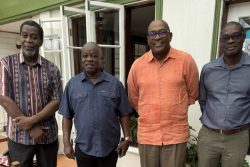Now that the Government has decided to resuscitate the Amaila Falls Hydropower Project, it is time to revisit the Project. In July – August 2013, we had carried three articles titled “Putting the cart before the horse: The Amaila Falls Hydropower Project”. This was at a time when there was a PPP/C-led minority government, and a huge controversy had erupted in the National Assembly as to whether the Project should proceed. The combined opposition, comprising the APNU and the AFC, was not in favour of an increase in the ceiling for the Government’s guarantees of loans to public corporations and State-owned/controlled companies in order to give coverage to the Power Purchase Agreement between Guyana Power and Light and Amaila Falls Hydro (AFH) Inc.
AFH Inc. was formed to construct, operate and maintain the Project over a 20-year period after which it was to be handed over to the Government free of cost – a form of Build, Own, Operate and Transfer (BOOT) arrangement. The two shareholders were Sithe Global and the Government of Guyana, with 60 percent and 40 percent equity interest, respectively. The actual construction was to be undertaken by China Railway First Group Ltd. whose parent company was blacklisted by the authorities in Norway over allegations of corruption. (See https://www.kaieteurnewsonline.com/2015/02/27/corruption-worries-over-amaila-falls-hydrogovt-stands-behind-chinese-contractor/) and https://www.kaieteurnewsonline.com/2015/02/26/stalled-amaila-falls-hydro-projectnorways-ethics-council-warns-of-corruption-with-chinese-company/. It was the same company that was awarded the contract for the East Coast Demerara Road Expansion Project.
We must state from the outset that we are not against any initiative that is aimed at moving away from the use of fossil fuels to renewable sources of energy, such as from water, wind and the sun. The evidence is overwhelming that the burning of fossil fuels is the main cause of global warming and climate change, as highlighted in the most recent United Nations report on climate and discussed in last week’s article. Our main concern, however, was about the financing arrangement which would have resulted in an estimated total project cost of U$840.3 million. This involved a mix of financing via debt (borrowings) in the amount of US$588.2 million and equity (shareholders’ contribution) of US$252.7 million, giving a debt to equity ratio of 70:30. With this mix, the company would have been considered highly geared in that there would have been significant financial risks, should revenue generated not be enough to meet operating costs, and more importantly to service the debt, including its repayment. The proposed borrowings were to be from the Inter-American Development Bank and the China Development Bank; while the equity portion was to be provided by Sithe Global and the Government of Guyana in the amounts of US$152.1 million and US$100.0 million, respectively.
We had emphasized that unlike equity, borrowings attract interest charges until the liabilities are fully discharged, thereby significantly increasing the cost of the Project. In fact, included in the project cost of US$840.3 million were amounts of: (i) US$97.1 million representing interest charges over the construction period; (ii) US$187.7 million in financing costs; (iii) US$34.9 million in lenders’ costs and advisory fees; and US$55.7 million in political risk insurance. All these costs, which total US$187.7 million or 23.34 percent of the overall cost, could be avoided if the Project was fully equity-financed, thereby reducing the project cost to US$652.6 million. Needless to mention, the total project cost had to be recovered in addition to a return on investment over the 20-year period, through the Power Purchase Agreement, which would eventually have to be borne by the electricity consumer via tariffs.
It was the same financing arrangement that saw the construction of the Berbice River Bridge and the Marriott Hotel. Both projects ran into serious financial difficulties upon completion because enough revenue was not generated to enable the projects to service the loans that were taken for their construction, thereby necessitating government intervention. In the case of the Marriott Hotel, the discovery of oil resources and ExxonMobil’s presence in Guyana saved the day for the hotel. Readers may wish to refer to the results of forensic audit on the Marriott Hotel undertaken by this columnist and available at https://finance.gov.gy/wp-content/uploads/2017/05/mariott.pdf. As regards the Berbice River Bridge, our analysis can be found at https://www.stabroeknews.com/2015/09/07/features/the-berbice-river-bridge-fiasco-the-public-interest-versus-the-private-interest/.
Given the above concern as regards the financing arrangement, we were of the view that the Project should have been fully-owned by the Government like any other government infrastructure development project. While there was merit in having a separate legal entity to administer the Project and to sell the electricity generated to the Guyana Power and Light, the Government could have followed the example of the Mahaica, Mahaicony, Abary-Agricultural Development Authority (MMA-ADA). This was the largest drainage and irrigation project in South America at the time. It was constructed in the late 1970s-early1980s mainly through the damming of the Abary River to create a water conservancy and a network of primary and secondary drainage and irrigation canals. As a result, 37,000 acres of land were made available for rice cultivation.
The MMA/ADA project was financed by two loans from the IDB totalling US$122.0 million and at least US$50.0 million in counterpart funding from the Government of Guyana. The contractor for the project was the Dutch firm of Ballast Needam International while the engineering consultant was the British firm of Sir William Halcrow & Co. This was in addition to the involvement of the top engineers of the country and other professional technical persons at the operational and board levels. (This columnist was the Finance Manager during the period 1985 to 1987.)
The water tariff was calculated to cover only the operational costs of the MMA/ADA since the two IDB loans became part of the public debt of Guyana to be serviced via a direct charge to the Consolidated Fund. This arrangement provided the much-needed financial relief to farmers and an incentive to engage in rice cultivation. It is indeed regrettable that successive Administrations have not seen it fit to follow through in the construction of similar facilities in the Mahaica and Mahaicony areas, as was the intention. This would have released an additional 75,000 to 100,000 acres of land for agricultural purposes.
We were not alone in expressing concern about the high cost of the Amaila Falls Project. Former Minister of Finance, Carl Greenidge, had argued that no evidence was produced to show how the electricity tariffs would be reduced as well as the basis of arriving at the amount of US$2 billion that the Guyana Power and Light had to pay AFH Inc. over the 20-year period under the Power Purchase Agreement. He suggested that, in view of the extremely high cost of transmitting the electricity to the national grid, the Project should not be a stand-alone one but rather part of cluster of hydro projects. On the other hand, Prof. Clive Thomas felt that the project as configured was not acceptable and that demand would outstrip supply by 2019. He suggested that it would be better to cut our losses and abandon the Project before it is too late.
Now back to the controversy in the Assembly over the Amaila Falls Project. A few weeks later, on 7 August 2013, the Assembly revisited the proposal to lift the ceiling for Government guarantees. This time, the combined Opposition was split on the issue, with the AFC supporting the proposed increase while the APNU voted against it. The AFC argued that it wanted to give the Project a “life line” and that its support was “conditional”. Sithe Global, however, withdrew from the Project, citing a lack of political consensus. This action brought the Project to a halt, only to be resuscitated upon a change in government in August 2020.
In the above-mentioned articles, we concluded that decision-makers need to exercise the greatest degree of caution and prudence in deciding whether to go ahead with the Project. In this regard, we had suggested that stakeholders needed positive assurances that:
Adequate mechanisms would be in place for the protection of the environment;
A thorough and independent evaluation, pronouncing definitively and conclusively that the Project is economically, technically and otherwise feasible, and that all associated risks have been properly addressed;
The Guyana Power and Light has the technical, operational and management capacity to perform satisfactorily under the proposed arrangement;
Independent review confirming that the electricity would indeed be reduced; and
A final reformulated cost of the Project would represent the best value for money.
Under the present arrangements, the BOOT model has been retained, except that the Government has dropped the idea of having a separate legal entity responsible for constructing, operating and maintaining the Project. Instead, it is the same company, China Railway First Group that was previously selected to construct the facility, will now be the BOOT developer/operator. However, the cost of the Project remains a concern. Under the previous arrangement, China Railway was the contractor, and the contract sum was US$519.6 million. The company will now be incurring US$700 million in construction costs, an increase of US$180.4 million. This is contrary to the statement reported made at the recently concluded energy conference that the construction cost will be less.
China Railway will be recovering the entire project cost over a 20-year period through the Power Purchase Agreement which will include recovery of the capital cost, interest during the construction period, financing costs, lender’s costs and advisory fees, and political risk insurance. The total construction cost of the Project will therefore be at least US$1,020.7 million (US$840.3 million + US$180.4 million = US$1,020.7 million). This is on the assumption that the indirect cost structure remains the same as that of the previous arrangement, though it may very well increase as a result of the passage of time.
We note that China Railway will be charging the Guyana Power and Light US$0.77 per KWH through the Power Purchase Agreement. According to economist Tarron Khemraj’s rough calculation, this will amount to US$2.2 billion over the 20-year period, or US$947.3 million in present value terms, assuming a 10-percent discount rate. (See https://www.stabroeknews.com/2022/03/07/news/guyana/use-oil-money-rather-than-boot-for-amaila-hydro-khemraj/). However, details of how the US$0.77 was arrived at were not made available. Mr. Khemraj also argued that it would have been more cost-effective if resources of the Natural Resource Fund were to be used to finance the Project:
Assume that the government has two options to fund a hypothetical project that costs US$100 million. It can seek BOOT financing for US$100 million. Or it can withdraw the same amount from the NRF to fund the project. Assume further that the BOOT financing attracts a repayment of US$130 million in interest over 10 years. Also, assume, that keeping the money in the NRF would have earned Guyana US$30 million after 10 years. From the numerical example, therefore, it clearly makes no sense to rely on the BOOT. Losing US$30 million in interest over 10 years is better than having to repay US$130 million after over 10 years.
To be continued –









